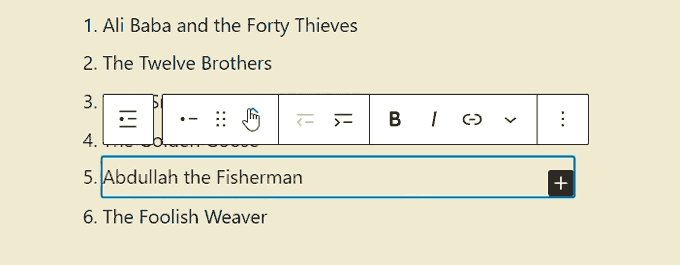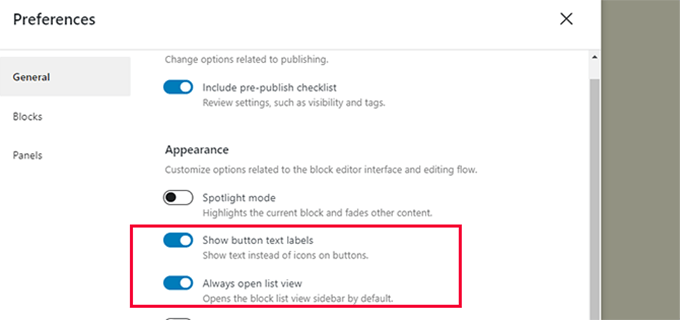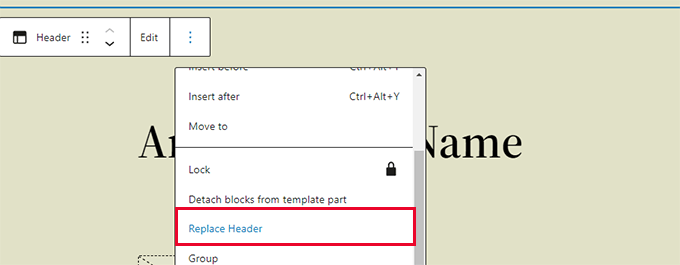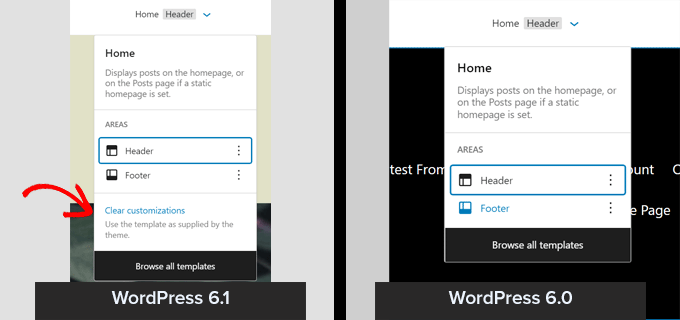
WordPress 6.1
WordPress 6.1 was released a few hours back, and it is the last major release of 2022.
This new release contains significant updates to the full site editing and the block editor experience.
Note: WordPress 6.1 is a major release, and unless you are on a managed WordPress hosting service, you’ll have to manually initiate the update.
Important: Don’t forget to create a complete WordPress backup before updating.
That being said, here’s all that’s new in WordPress 6.1.
Twenty Twenty-Three – New Default Theme
WordPress 6.1 ships with a brand new default theme called Twenty Twenty-Three.

Out of the box, this theme features a minimalist design that looks like a blank canvas and encourages you to bring your own style to the theme.
It comes packed with 10 style variations that users can choose from inside the Site Editor. All of these styles are fully customizable using the site editor.

Twenty Twenty-Three also ships with four fonts that are used by different style variations. You can also use these fonts when writing posts or pages.

Twenty Twenty-Three can be a perfect starter theme for users who want to make a website using the block editor with their own styles and layouts.
Block Editor Changes in WordPress 6.1
The block editor is where users write content, create pages, and edit their themes.
Each WordPress release comes with major improvements, new features, and enhancements to the block editor.
Following are a few most noticeable changes in the block editor.
List and Quote Blocks Now Have Inner Blocks
One of the problems with bulleted lists was that if you wanted to move a list item up and down you had to manually delete and edit all the list items.
WordPress 6.1 brings inner blocks for Quote and List blocks. Basically, each list item is its own block and you can move list items up and down.

The Quote block is now also divided into inner blocks.
Now you can style quote and cite blocks differently.

Featured Image in Cover Block
With WordPress 6.1, you can now select the featured image to be used for a cover block. After that, you can just set the featured image and it will start appearing inside the cover.

Many beginners often confuse cover block and featured images. Hopefully, this will now allow them to just use cover block to display featured image for an article.
Note: Depending on your theme, you may see the featuerd image appear twice. First, at the location where your theme displays the featured image and then as the cover block.
New & Improved Borders
WordPress 6.1 brings a lot of options to the design tools available for blocks. One of them is the more powerful border tool that is now available for several blocks.
You can use set top, right, bottom, left borders separately, and give them different colors and sizes.

Previously users were able to only select the border radius for the image block.
Now with WordPress 6.1, you can set border color and size as well.

More Padding and Margin Options
WordPress 6.1 brings ‘Dimensions’ tool to more blocks allowing users to set padding and margins.

Users will also be able to visualize their changes with neat visual hints.

You can also set margins for Spacer and Separator blocks, which allows you to create more spacious content layouts.
New and Improved Navigation Blocks
WordPress 6.1 now allows you to easily change background and text color for sub-menus.

The Navigation now also allows you to easily choose a menu from the block toolbar or the sidebar panel.

Editor Design Refinements in WordPress 6.1
WordPress 6.1 ships with some noticable refinements to Editor design. These changes clean up the interface and aim to improve user experience.
Status & Visibility Panel Renamed to Summary
The Status & visibility panel is renamed to Summary. Template and Permalink panels are now removed and merged into the Summary panel.

You can click on the URL field to change the Permalink or Template name to change template.
Here is how it looked in WordPress 6.0 vs WordPress 6.1.

Time to Read in the Information Panel
The information panel now includes ‘Time to read’ information as well.

Site Icon Replaces the WordPress Logo
If you have set the site icon for your website, then it will be used as the View Posts button in the top left corner of the screen.

New Preferences Options
The Preferences section for the block editor now includes two new options.

First, there is ‘Always open list view’ which shows the list sidebar by default for all articles.
Then, there is ‘Show button text labels’ which replaces icons in toolbars with text labels.

Create More Templates in Site Editor
If you have used child themes with classic WordPress themes, then you may be familiar with the template heirarchy.
With WordPress 6.1, users are now able to do the same using the block editor and without writing code.
You can use the following templates regardless of which block theme you are using.
- Single page
- Single post
- Indivdual term in a taxonomy
- Individual category
- Custom template (can be used for any post or page)
You can go to the Appearance » Editor page and then select templates from the left sidebar. After that, click on the Add New button to see the available options.

Choosing a template that can be applied to an individual item, will see bring up a popup.
From here, you can choose the item where you want the new template to be used.

For instance, if you choose the Category template, then you’ll see a popup.
Now you can select if you want to apply your new template for all categories or a specific category.

Quickly Search and Use Template Parts
The site editor in WordPress 6.1 now makes it easier to discover and use template parts.
For instance, if your theme had multiple template parts that can be used in the header, then you can simply click on the template part options and select Replace.

This will bring up a modal popup where you can look for available template parts that you can use.

Quickly Clear Customizations in Site Editor
WordPress 6.1 now allows you to quickly clear customizations when working in Site Editor.

Under the Hood Changes in WordPress 6.1
WordPress 6.1 comes with several important changes for developers. Following are a few of these changes.
- Classic themes can now use template parts
- Fluid typography allows theme developers to dynamically adjust font sizes
- Post types can now have their own starter patterns
- Filters to hook into theme.json data
- Simplified data access with React hooks in WordPress 6.1
- New is_login() function to for determining if a page is the login screen.
WordPress.org Is More Flexible For Most Users
One of the amazing things about WordPress is its vibrant third-party theme and plugin communities. Themes and plugins essentially let you make huge changes to how your WordPress site both looks and functions.
With WordPress.org, you’re free to install whatever WordPress themes and plugins you want, while WordPress.com doesn’t let you install themes and plugins on most plans.
Can You Install Third-Party Extensions on WordPress.com?
For the longest time, the answer to the question was a hard, no. Now, recent changes make it a bit murkier, though the answer is still no for the majority of WordPress.com users.
Since August 2017, WordPress.com users who pay for the $300 (per year) Business plan have the ability to install third-party WordPress themes and plugins. That gives those users basically the same power to install extensions as self-hosted WordPress users.
Users on all other plans, including both free and paid, are not so lucky. That is, users on Free, Personal, or Premium WordPress.com plans cannot install third-party themes and plugins.
This is one of the major downsides of WordPress.com:
WordPress.com essentially sacrifices flexibility in exchange for simplicity.
If you just want a casual hobby blog, that tradeoff might be worth it to you. But if you want a site that you can adapt and truly make your own, you’ll find that much easier to accomplish with WordPress.org.
Can You Install Third-Party Extensions on WordPress.org?
We already kind of teased the difference here, but let’s run through it quickly anyway.
With WordPress.org, you can install any one of the tens of thousands of third-party themes, plugins, and WooCommerce extensions on your site. You have 100% control of what happens on your site.
Are you looking for Cheap WordPress 6.1 Hosting? Finding a high quality Cheap WordPress 6.1 Hosting provider is crucial for your web application. Your WordPress 6.1 application can only run smooth if it will be hosted on a server which can provide a higher up time & plenty of computing resources. There’re thousands of web hosting providers which offer asp.net hosting, but choosing Cheap WordPress 6.1 Hosting provider is a time consuming task. To make your buying decision easy we’ve concluded 3 Best yet Cheap WordPress 6.1 Hosting providers which are reliable and offer affordable WordPress 6.1 Hosting so that every one can afford it.
Cheap and Reliable WordPress 6.1 Hosting
|
|
|
|
|---|---|---|
| ASPHostPortal | DiscountService.biz | UKWindowsHostASP.NET |
| $1.00/month | $2.00/month | £3.00/month |
| Host 1 Site | Host 1 Site | Host 5 Sites |
| 1 GB Disk Space | 1 GB Disk Space | 1 GB Disk Space |
| 10 GB Bandwidth | 10 GB Bandwidth | 20 GB Bandwidth |
| Dedicated Application Pool | Dedicated Application Pool | Dedicated Application Pool |
| Support UTF-8 Domains | Support UTF-8 Domains | Support UTF-8 Domains |
| 30-Days Money Back | 30-Days Money Back | 30-Days Money Back |
| Latest ASP.NET | Latest ASP.NET | Latest ASP.NET |
| Plesk Control Panel | Plesk Control Panel | Plesk Control Panel |
| Windows 2008/2012 | Windows 2008/2012 | Windows 2008/2012 |
| SQL Server 2008/2012/2014 | SQL Server 2008/2012/2014 | SQL Server 2008/2012/2014 |
| Latest MySql version | Latest MySql version | Latest MySql version |
How to Choose Cheap and Reliable WordPress 6.1 Hosting?
Reliability and Speed of Access
Not only should the web host be reliable and fast, it should guarantee its uptime (the time when it is functional). Look for a minimum uptime of 99%. In fact, even 99% is actually too low — it really should be 99.5% or higher. The host should provide some sort of refund (eg prorated refund or discount) if it falls below that figure. Note though that guarantees are often hard to enforce from your end — especially if the host denies there was any downtime. However, without that guarantee, the web host will have little incentive to ensure that its servers are running all the time.
Data Transfer (Traffic/Bandwidth)
Data transfer (sometimes loosely referred to as “traffic” or “bandwidth”) is the amount of bytes transferred from your site to visitors when they browse your site.
Don’t believe any commercial web host that advertises “unlimited bandwidth”. The host has to pay for the bandwidth, and if you consume a lot of it, they will not silently bear your costs. Many high bandwidth websites have found this out the hard way when they suddenly receive an exorbitant bill for having “exceeded” the “unlimited bandwidth”. Always look for details on how much traffic the package allows. I personally always stay clear of any host that advertises “unlimited transfer”, even if the exact amount is specified somewhere else (sometimes buried in their policy statements). Usually you will find that they redefine “unlimited” to be limited in some way.
In addition, while bandwidth provided is something you should always check, do not be unduly swayed by promises of incredibly huge amounts of bandwidth. Chances are that your website will never be able to use that amount because it will hit other limits, namely resource limits.
To give you a rough idea of the typical traffic requirements of a website, most new sites that don’t provide video or music on their site use less than 3 GB of bandwidth per month. Your traffic requirements will grow over time, as your site becomes more well-known, so you will need to also check their policy when you exceed your data transfer limit: is there a published charge per GB over the allowed bandwidth? Is the charge made according to actual usage or are you expected to pre-pay for a potential overage? It is better not to go for hosts that expect you to prepay for overages, since it is very hard to forsee when your site will exceed its bandwidth and by how much.
Disk space
For the same reason as bandwidth, watch out also for those “unlimited disk space” schemes. Many new sites (that don’t host videos or music) need less than 20 MB of web space, so even if you are provided with a host that tempts you with 100 GB (or “unlimited space”), be aware that you are unlikely to use that space, so don’t let the 100 GB space be too big a factor in your consideration when comparing with other web hosts. The hosting company is also aware of that, which is why they feel free to offer you that as a means of enticing you to host there.
Technical support
Does its technical support function 24 hours a day, 7 days a week (often abbreviated 24/7), all year around? Note that I will not accept a host which does not have staff working on weekends or public holidays. You will be surprised at how often things go wrong at the most inconvenient of times. Incidentally, just because a host advertises that it has 24/7 support does not necessarily mean that it really has that kind of support. Test them out by emailing at midnight and on Saturday nights, Sunday mornings, etc. Check out how long they take to respond. Besides speed of responses, check to see if they are technically competent. You wouldn’t want to sign up with a host that is run by a bunch of salesmen who only know how to sell and not fix problems.
Email, Autoresponders, POP3, Mail Forwarding
If you have your own site, you will probably want to have email addresses at your own domain, like sales@yourdomain.com, etc. Does the host allow you to set up whatever email addresses you want on your domain, so that mail can be forwarded to your current email address, or placed into a mail box on your web hosting account itself? Can you set an email address to automatically reply to the sender with a preset message (called an autoresponder)? Can you retrieve your mail with your email software?
Control Panel
This is called various names by different hosts, but essentially, they all allow you to manage different aspects of your web account yourself. Typically, and at the very minimum, it should allow you to do things like add, delete, and manage your email addresses, and change passwords for your account. I will not sign up with a host where I have to go through their technical support each time I want to change a password or add/delete an email account. Such tasks are common maintenance chores that every webmaster performs time and time again, and it would be a great hassle if you had to wait for their technical support to make the changes for you.
Web Server and Operating System
Is the type of operating system and server important?
In general, most people will want to sign up for a web host offering a Unix-based system (like Linux, FreeBSD or OpenBSD) and running the Apache web server. Most web-based software assume your website is running on such a system, and you will usually experience fewer compatibility issues with it. There are also a lot of guides available on the Internet on configuring such systems, so finding help when you need it is easier as well.
In my opinion, the only time when you will want to use a Windows server is if you’re running Windows-specific programs, like ASP scripts. But even then, you’ll probably be better off looking for a PHP-equivalent, and using a Unix-based system.
Price
I was actually hesitant to list this, but I guess it’s futile not to. However, I would caution that while price is always a factor, you should realise (“realize” in US English) that you often get what you pay for, although it’s not necessarily true that the most expensive hosts are the best.
Monthly/Quarterly/Annual Payment Plans
Most web hosts allow you to select an annual payment plan that gives you a cheaper rate than if you were to pay monthly. My current personal preference is to pay monthly with all new web hosts until I’m assured of their reliability and honesty. Paying monthly allows me to switch web hosts quickly when I find that the current host does not meet my requirements: this way, I’m not tied down to a bad web host because I have prepaid for an entire year. I do this even if the new web host guarantees that they will refund the balance if I’m dissatisfied, since at the point I sign up, I have no assurance that they will honour their guarantee. Later (usually after a couple of years), when I’m satisfied with the host, I may change payment plans to the discounted annual plans.
Resellers?
Not all hosting companies own or lease their own web servers. Some of them are actually resellers for some other hosting company. The disadvantage of using a reseller is the possibility that you are dealing with people who don’t know much about the system they are selling and who take longer to help you (they have to transmit your technical support request to the actual hosting company for it to be acted upon). However, this also depends on both the reseller and the underlying hosting company. It is thus wise not to rule out all resellers; there are a number of reliable and fast ones who are actually quite good and cheap. In fact, a number of resellers sell the same packages cheaper than their original hosting company. If you find out that a particular company is a reseller, you will need to investigate both the reseller and the real hosting company.
International
If you don’t stay in the USA, you have the option of hosting your site with some local provider. The advantage here is the ease of dealing with them (they are after all easily accessible by phone call or a visit), your familiarity with the local laws and easy recourse to those laws should it be necessary. It should be your choice if your target audience is local (eg a local fast food delivery service). On the other hand, hosting it in USA has the advantage of faster access for what is probably the largest number of your overseas visitors (particularly if you have an English-speaking audience). You also have a large number of hosting companies to choose from, and as a result, cheaper prices too.








